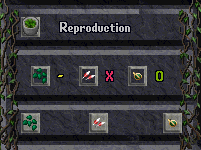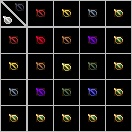Cross Pollination
Return to: Gardening EssayPlantgrowing | Cross Pollination | Plant Crossing | Plant Colors | Fragrant & Peculiar Seeds & Plants | Colored Plant Oddities | UO Botany and Nutrition Forum
| Cross Pollination | |||||||||||||||||||||||||||||||||||||||||||||||||||||||||||||||||||||||||||||||||||||||||||||||||||||||||||||||||||||||||||||||||||||||||||||||||||||||||||||||||||||||||||||||||||||
Cross-Pollination When a plant first reaches its full-grown state, it will sprout its full foliage, no longer contained within the plant bowl. At this stage of the plant’s growth, it will begin to produce pollen. You can view your plant’s current Pollination State in the Plant Resources Menu. The plant will eventually self-pollinate if left unattended, and the plant will begin to produce seeds. Seeds produced by a self-pollinated plant will grow up into an exact duplicate of the ”parent” plant. Plants will only give pollen on days 7 through 9 of their growth cycle. Something to consider if you want to gather the pollen instead of letting the plant self-pollinate.Another method of pollination is called ”cross-pollination”. Once a plant reaches the pollen-producing stage, its pollen may be gathered by the owner by using the Cross-Pollination button. Gathered pollen may be used on another full-grown plant. When you pollinate one plant with pollen from another plant, the targeted plant will produce seeds that will grow into a hybrid of the two plants. The color and type of each ”parent” plant are combined to produce a new type of seed that will grow from the targeted plant.While you may continue to gather pollen from a plant throughout its entire life cycle, once a plant has been pollinated (either by itself, through natural pollination, or through manual cross-pollination from another plant), no further combinations may be performed. The seed type that the plant will produce is determined the first time the plant is pollinized, and cannot be changed afterwards.In very rare circumstances, cross-pollination may result in a ”mutation”. If mutation occurs, the targeted plant will not produce seeds that are a combination of the two ”parent” plants, but will instead produce ”mutated” seeds that grow into mutant plant varieties.Known mutation colors are black and white. There’s about a 1% chance for this to happen.Pollination State When a plant first reaches its full-grown state, it will sprout its full foliage, no longer contained within the plant bowl. At this stage of the plant’s growth, it will begin to produce pollen. You can view your plant’s current Pollination State in the Plant Resources Menu. The plant will eventually self-pollinate if left unattended, and the plant will begin to produce seeds. Seeds produced by a self-pollinated plant will grow up into an exact duplicate of the ”parent” plant. Plants will only give pollen on days 7 through 9 of their growth cycle. Something to consider if you want to gather the pollen instead of letting the plant self-pollinate.Another method of pollination is called ”cross-pollination”. Once a plant reaches the pollen-producing stage, its pollen may be gathered by the owner by using the Cross-Pollination button. Gathered pollen may be used on another full-grown plant. When you pollinate one plant with pollen from another plant, the targeted plant will produce seeds that will grow into a hybrid of the two plants. The color and type of each ”parent” plant are combined to produce a new type of seed that will grow from the targeted plant.While you may continue to gather pollen from a plant throughout its entire life cycle, once a plant has been pollinated (either by itself, through natural pollination, or through manual cross-pollination from another plant), no further combinations may be performed. The seed type that the plant will produce is determined the first time the plant is pollinized, and cannot be changed afterwards.In very rare circumstances, cross-pollination may result in a ”mutation”. If mutation occurs, the targeted plant will not produce seeds that are a combination of the two ”parent” plants, but will instead produce ”mutated” seeds that grow into mutant plant varieties.Known mutation colors are black and white. There’s about a 1% chance for this to happen.Pollination StateThe Pollination State indicator
|
|||||||||||||||||||||||||||||||||||||||||||||||||||||||||||||||||||||||||||||||||||||||||||||||||||||||||||||||||||||||||||||||||||||||||||||||||||||||||||||||||||||||||||||||||||||
Last modified: February 10, 2013







 Brightness:
Brightness:
















maby my eyes are just going bug eyed trying to figure this out but i would like to present a set of crossings maby you will be able to tell me if it adds up right.
fern -> elephant ear = fern
fern -> pampas grass = rushes
fern -> bulrushes = pampas grass
fern -> snake plant = small palm
fern -> lilies = rushes
fern -> ponytail palm = fern
fern -> poppies = lilies
this is just 1 crossing set i did. i also did an additional 10 raised gardens with different combos but that would be way to many to list here. tell me if that set i just showed makes the correct sense
ps you need a better human verification. i have to fight with the bloody thing for 20 minutes or more every time i try to post here. and usually just give up in complete frustration. I have already completed 15 puzzles and every one has been rejected by it so far no matter how closely i study and type in the answer
1Katana,
Sorry this reply might be a little late. They’ve added a few new plants now. It seems crossing cactus doesn’t get you what this chart says it will anymore.
But, for the most part it’s right. If you have an even number between the two plants you are crossing, in your examples the fern + pampas grass, you have a 50/50 chance of getting either the rushes or an elephant ear.
Hope this helps
2Francine
So I’m really new to gardening and am trying to figure this out… what about plant combinations where there’s not an exact halfway point, like, say, a fern and a snake plant? I’m not sure if it would be a small palm or a century plant.
3It says this above:
Where plants have an even number of grid squares between the resulting cross has a 50/50 chance of being either of the two central plants between. Example Pampas Grass plus Fern or Lilies plus Ponytail Palm have a 50/50 chance of producing either Rushes or Elephant Ear.
4great chat but ive the crossings down the right hand side using the fern tried all but the first 2 and i didnt get any of the plants that it said i should ether the seeds are bugged or they dont use that crossing any more. so far i have found 16 different types of plants droping off the boglings and bogthings in the colors of red blue yellow and plain. i have yet to try all the crossing on this chart yet but plan to do so but so far nothing has been lining up except the color crossing. but i wind up with a completely different plant then the chart says.
5Katana,
Not sure on how you are going about the crossings. Remember that if you cross a fern with a Tribarrel Cactus for instance you should get a water plant.
The table works by whatever plant is halfway between two others is the result of a cross. So fern and small palm should get a ponytail palm.
Kayne
6